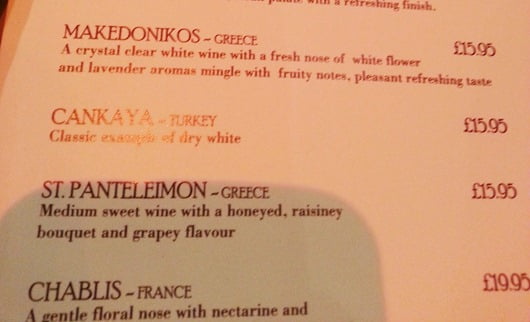Sh*t That Wine Lists Say: British Edition.
October 22, 2012
Anyone can critique a wine list. Anyone. It’s easy, mainly for the reason that there are, to a certain extent, very few right and wrong answers.
Ok, maybe that’s not entirely true! There are a few unofficial rules, but they obviously change according to the type of restaurant you’re dealing with. With that said, the next few photos are from my recent trip back to England, when I dined at a reputable Greek/Turkish restaurant in my hometown. I don’t want to pick-on this restaurant. The meal was great. Way better than what I had expected from the tiny town of Brighouse!
What we are really looking at in these photos are the descriptions on each of the wines. Personally, I’ve never been a huge fan of wine descriptors, whether in wine reviews or on wine lists. This is a stance I took a long time ago. One man’s blackberry is another man’s plum (so to speak). Would you really choose a particular wine based on a restaurant wine list description of certain flavors? Would you pass-up a wine that has “cranberry” in the descriptor if you’re not a fan of cranberries?
If you answered yes to both those questions, then I’m here to tell you that you’re choosing wines all wrong!
Wine list descriptions are most-often created by the restaurant themselves (sometimes with a little help from a wine distributor). The reason that restaurants use them is a misguided attempt to try and give you a tiny education on what you can expect from the juice in the bottle, with the added bonus that they also don’t have to train their staff on the intricacies of wine appreciation and selling/matching/pairing techniques. That’s not my personal opinion. That’s a fact.
The only reason that I even include descriptors in my actual wine reviews is that I know people still want them…but that doesn’t make it right! I’m ok with people who take this stance, but I think that one of the most essential things you should learn when first getting into wine is how to recognize certain flavor characteristics, rather than being told what you taste.
On to the wine list!!!

As I said in the beginning, ANYONE can pick holes in a wine list, but this one is particularly easy. First and foremost, I’m guessing that they’re assuming the customer doesn’t really NEED to know the actual winery name. Simply the grape and country will apparently suffice. You may have had this South African Shiraz before, but you would never know it, since you don’t get to see the brand name listed!
Again referencing the photo above: Does anyone else think Merlot got an unfair deal in this whole description thing? Shiraz gets a two line descriptor, but poor old Merlot is left at the mercy of hoping that people have tasted it before. FYI: I very rarely find Chilean Merlot to be a “typical” example of the grape.

I’m fairly certain that this is the first time I have seen “glitteringly” used on a wine list. Fair play to them for that, and on a Pinot Grigio of all things!
With this particular wine, the three flavors to expect (based on this descriptor) are: lime zest, vanilla and spice. I don’t know about you. but that sounds bloody awful! It sounds closer to a body wash than a bottle of wine.

Not much to say about the Turkish Cankaya, simply: “Classic example of dry wine.” That leaves it open to a hell of a lot of interpretation! And a “pleasant refreshing taste” on the Greek wine above it. Breaking news: that applies to about 95% of white wines in the world!
I wasn’t really hoping to draw any real conclusions from this post and I certainly don’t plan on continuing to take photos of wine lists and critiquing them as a long-term feature, mainly because it’s bad Karma. In conclusion, he’s the advice I’d like to finish with:
For wine drinkers:
Never-ever use the description on a wine list as the sole basis for your choice. It typically gives you about as much truthful/accurate information on the wine itself as both the presidential candidates gave/are giving you on what they will do if/when they serve their 4 years. None! It’s all BS. It means nothing. It’s all marketing.
Your absolute best bet is to speak to your Server/Bartender and see if they can offer any guidance based on previous wines you’ve enjoyed. If you don’t feel like you’re getting the information you need out of him/her, you can ask for a small taste of the wine you are thinking of. Seriously. Most restaurants are more than happy to oblige, and if they’re not, you should feel free to tip accordingly and then never frequent that place again!
For restaurant/bar owners:
Are wine descriptors really worth it? What do they really achieve? We both know that they’re a waste of space on a wine list. Maybe it’s worth training your staff a little more on matching guests with wines that they will love (also with the chance for an upsell), rather than having them rely solely on what’s printed on the menu. I PROMISE YOU that it will pay-off in the long-run!










